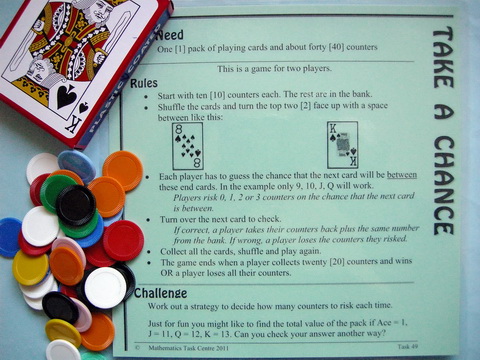
Take A ChanceTask 49 ... Years 4 - 10SummaryStudents explore their intuitive concept of 'good chance' in a game situation. The pack is shuffled and the top two cards are placed as the 'ends'. Students are invited to risk counters, or pass, on the fall of the next card. You win if the card is between the ends. If it's not, you lose.Problem: What is the best strategy to use to decide how many counters to risk? |
Materials
Content
|

IcebergA task is the tip of a learning iceberg. There is always more to a task than is recorded on the card. |
The task card is designed to place students in a position where they have to make intuitive probability judgements. The iceberg involves analysing that intuition with a view to deciding the best strategy for risking counters. To encourage this analysis you could ask students:
Suppose a game stall at the local fair always uses 4 and Jack as the ends. You have to pay $1 to turn over the top card. If it is between you get your money back. If it is not between you lose your money. At the end of the day do you think the stall owner will make a profit? |
Whole Class InvestigationTasks are an invitation for two students to work like a mathematician. Tasks can also be modified to become whole class investigations which model how a mathematician works. |
This can become a whole class investigation with just one card pack for the teacher and sufficient counters for each group. Pairs of students play against the teacher, starting with 10 counters each pair. Pairs also need a 'pot' of additional counters to add to or take from depending on how their risking works out. The class game ends when one pair has 20 counters or one pair loses all their counters. One Poly Plug red board between two is perfect for this. Each pair begins with 10 plugs out of the board. They play until one team either has 20 out of the board and wins, or one team has all their plugs back in the board and loses. A detailed lesson plan for Take A Chance can be found on Maths300. For more ideas and discussion about this investigation, open a new browser tab (or page) and visit Maths300 Lesson 170, Take A Chance, which includes an Investigation Guide. Visit Take A Chance on Poly Plug & Tasks. |
Is it in Maths With Attitude?Maths With Attitude is a set of hands-on learning kits available from Years 3-10 which structure the use of tasks and whole class investigations into a week by week planner. |
The Take A Chance task is an integral part of:
The Take A Chance lesson is not included in any MWA kit (it was developed after they were published), but it could be used to enhance the Years 5 & 6 or Years 9 & 10 Chance & Measurement kits. |